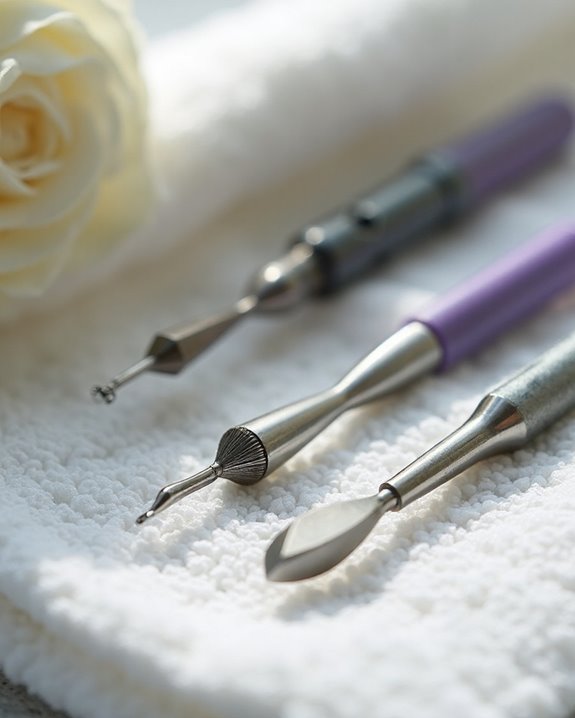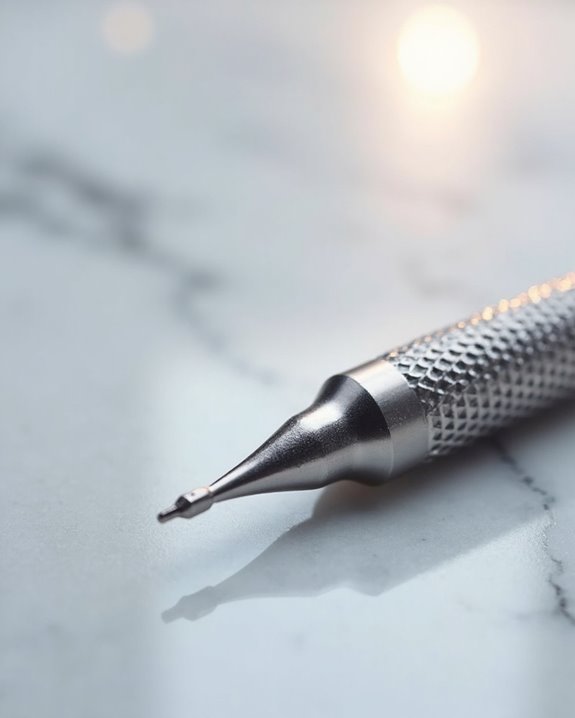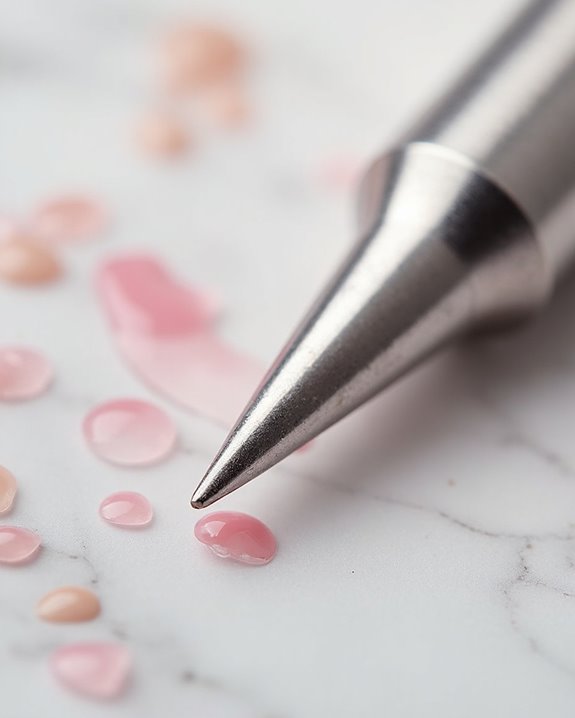For cuticle care, you’ll want a fine-grit ball-shaped or flame-shaped nail drill bit, ideally with a 1.8 mm diameter, to gently clean the cuticle area and sidewalls without harming the natural nail. These bits, often made of diamond or ceramic, provide precision and safety, especially when used at low speeds of 7,000 to 13,000 RPMs, while minimizing skin sensitivity. Stick with rounded-top designs for added protection. There’s more to explore on proper techniques and maintenance.
Key Takeaways
- Ball-shaped bits with 1.8 mm diameter are ideal for gently cleaning cuticles and sidewalls.
- Flame-shaped bits, like fine-grit Russian Flame, excel at opening cuticle pockets and clearing debris.
- Diamond bits with fine grits offer precise, gentle removal of dead cuticle tissue.
- Safety bits with rounded tops prevent damage to natural nails during cuticle care.
- Operate bits at 7,000-13,000 RPMs in reverse with light pressure for safe results.
Understanding Nail Drill Bits for Cuticle Work
How can you choose the right nail drill bit for effective cuticle care? When focusing on cuticle work, you’ve gotta understand the tools, like the Ball Bit, which is designed for exfoliating and cleaning hard, dead skin around nails, often with a fine grit for safety on sensitive areas. Similarly, the Flame bit, known for precision, helps open the cuticle pocket and clear debris, ensuring gentle yet thorough care with its fine-grit design.
For durability, Diamond bits and Carbide bits stand out, especially for cleaning the cuticle area and sidewalls, as they efficiently remove non-living tissue with precise diameters, like 1.8 mm heads. By selecting the right bit, you’ll achieve professional results, maintaining nail health without risking damage.
Professionals often recommend tungsten carbide bits for their superior durability and heat dissipation in cuticle work.
Key Shapes for Effective Cuticle Care

When it comes to mastering cuticle care, selecting the right nail drill bit shape is essential for achieving professional results, ensuring both precision and safety during the process. You’ll find that specific bits, like ball-shaped ones with a 1.8 mm head diameter, gently clean the cuticle area, removing dead skin from side walls without harm, while offering controlled handling.
Flame-shaped bits, such as the fine-grit Russian Flame, open the cuticle pocket effectively, clearing debris for a refined nail bed, and pair well with a tapered shape for detailed work. Rounded top bits, sometimes with a flat top design, access the proximal fold safely, exfoliating skin precisely, while pointed bits target tight areas, ensuring a deeper, thorough clean around the cuticle. For enhanced durability and reduced vibration, opt for tungsten carbide bits that excel in heat dissipation during cuticle tasks.
Material Choices and Their Impact on Cuticles

Selecting the right material for your nail drill bit is essential for effective cuticle care, as each type offers distinct benefits and challenges when working on delicate skin areas. Diamond bits, with their fine grits, gently clean the cuticle and remove dead cuticle tissue without damaging the surrounding cuticle area, making them ideal for sensitive skin. Carbide bits, like the Flame Carbide, excel in cuticle work by efficiently targeting stubborn areas at low to medium speeds, though you’ve gotta control the RPM to avoid overheating.
Meanwhile, ceramic bits, with fluted designs, provide a scooping action to exfoliate gently, serving as excellent bits to remove buildup. Choose wisely, as the material directly impacts how safely and effectively you maintain healthy cuticles. Additionally, ball-shaped bits offer precision cuticle removal with minimal risk of damage to natural nails, making them a top choice for professional nail techs.
Safety Considerations for Cuticle Drilling
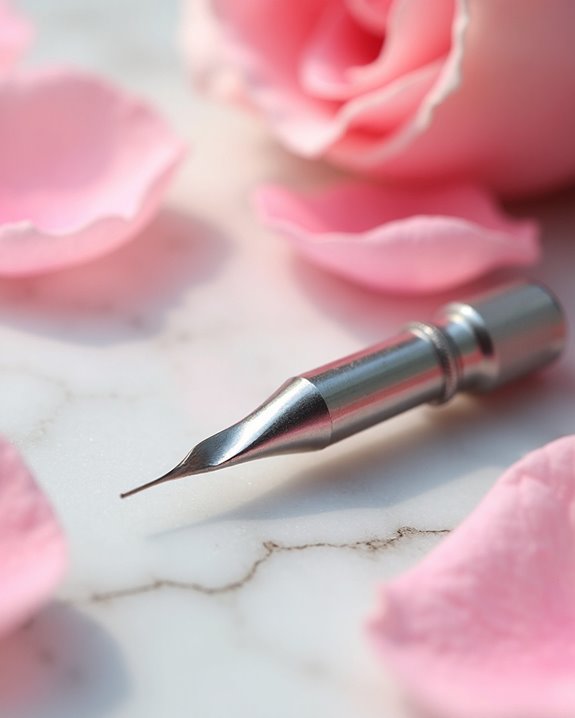
Beyond the choice of material for your nail drill bit, paying attention to safety during cuticle drilling is a key factor in protecting delicate skin and achieving a polished result. When you’re working to clean up the cuticle, especially with overgrown cuticles, make sure to select the right nail bits, like safety bits with rounded tops, which are ideal as the bit to use for beginners due to their gentle design that avoids damaging the natural nail or sidewalls.
Opt for fine or very fine grit bits, often used to clean sensitive areas, and operate them in reverse at 7,000 to 13,000 RPMs with light pressure, ensuring you prevent over-processing or skin sensitivity. Always disinfect metal bits after use to maintain hygiene.
Step-by-Step Guide to Using Cuticle Bits

Five essential steps can guide you through using cuticle bits effectively, ensuring both safety and precision in your nail care routine. First, select a safety cuticle bit, like a rounded top, to gently work around the nail plate, avoiding damage to the proximal fold as a beginner in this Guide to Nail Drill use. Second, operate your Drill at 7,000-13,000 RPMs in reverse, applying light pressure to remove hard skin and clean the nail plate, minimizing sensitivity risks. Third, switch to a pointed or flame-shaped bit for tight areas, targeting buildup in the sinus or lateral fold, ensuring thorough dead cell removal. Fourth, complete cuticle work on all nails before adjusting settings, streamlining the process. Finally, clean up after your session.
Maintenance Tips for Cuticle Drill Bits
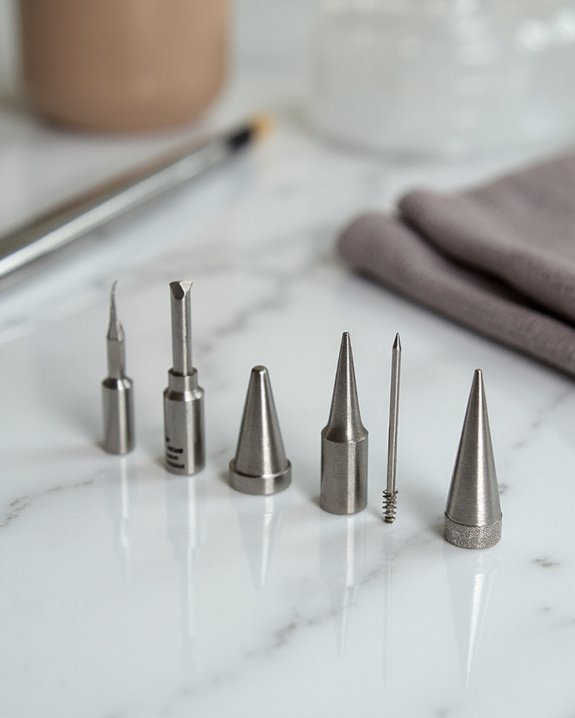
Maintaining your cuticle drill bits properly guarantees they remain effective and safe for every manicure session, building on the importance of using them correctly as outlined in the earlier steps. With a professional nail drill, whether using a Mandrel bit or others, you’ve got to clean them after each use by scrubbing with a small brush, soap, and warm water to remove debris. Nail drill bits come in various materials, like carbide, so avoid prolonged soaking in disinfectant—stick to the label’s timing—to prevent erosion.
Next, dry them completely to avoid rust, especially with an electric nail setup, and store them in a case. Use this bit responsibly, avoiding overheating during product application, by maintaining safe RPMs between 7,000-13,000.
Selecting the Right Bit for Your Cuticle Needs
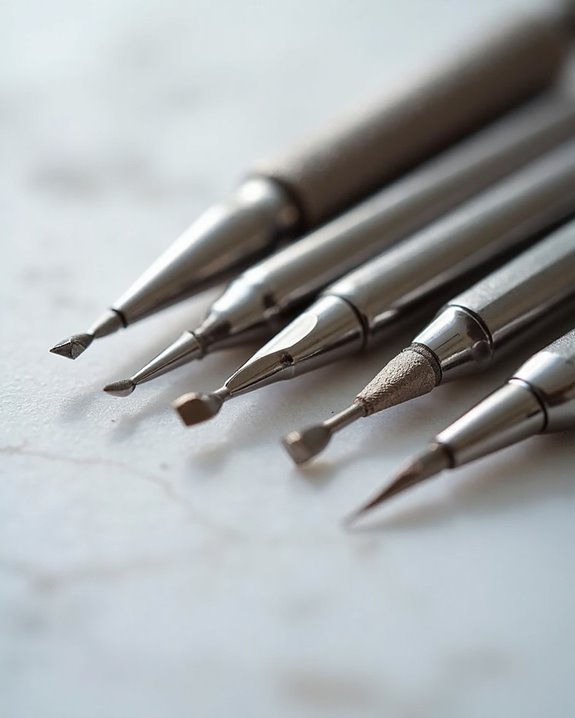
How do you choose the perfect nail drill bit for your cuticle care needs, especially when faced with varied client conditions and nail types? When aiming for a perfect manicure, start by evaluating the nail and cuticle condition, then select a bit suited for a dry manicure, ensuring safety near the nail bed. For fluffy cuticles, use rounded top bits to reshape and push into the proximal fold, providing deep access without harm.
For tight areas like the sinus, pointed bits are great for removing buildup, targeting dead skin precisely. Flame-shaped bits, like the fine-grit Russian Flame, clean under pockets efficiently. Flat top bits at 7,000-13,000 RPMs exfoliate gently, while ball-shaped bits from diamond sets offer Everything You Need for thorough cuticle care.
Frequently Asked Questions
What Drill Bit Do I Use for My Cuticle?
Wondering what drill bit to use for your cuticle? Hang tight! For Bit Cleaning, prioritize Shape Selection like a ball bit, verify Speed Adjustment, trust Brand Reliability, check Material Durability, and follow Technique Tips.
Can You Use a Nail Drill on Cuticles?
Hey, can you use a nail drill on cuticles? Absolutely, but watch for Safety Risks and Skin Damage. Follow Usage Tips, avoid Beginner Mistakes, maintain Hygiene Practices, and consider Alternative Methods for safety.
Which E-File Bit Is for Cuticles?
Hey, did you know 80% of nail techs prefer ball bits for cuticles? When picking an e-file bit for Cuticle Prep, consider Bit Durability, Speed Settings, Technique Variations, Material Choices, and Efile Alternatives.
What Is a Bit That Can Be Used at the Cuticle?
Hey, if you’re wondering what bit works at the cuticle, try a safety bit for Cuticle Hygiene. Focus on Bit Maintenance, Tool Alternatives, Speed Settings, Pressure Control, and don’t skip Aftercare Tips.

